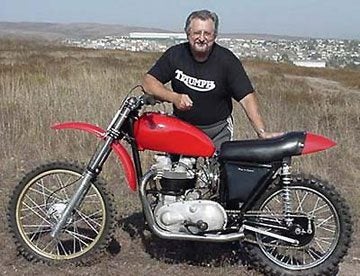 Don’t Ask!
Don’t Ask!
Go ahead, but if your question is stupid, you’ve been warned…
If you choose to email a question to this forum, then you must conduct yourself accordingly. Therefore, the following rules are in order:
1. Do not write your email to me IN CAPS. If you do so, I will print out your question and do terrible things to it.
2. Do not request a personal e-mail response. Since I get thousands of questions each month, trying to answer them all would cut deeply into my leisure time, which I value more than your current state of confusion.
3. Try to spell at least in a semi-correct fashion. If you choose to mangle the English language, expect no mercy from this quarter. You might be mocked severely.
4. Do not ask for me to send you copies of my many manuals and literature. I am not in the library business, nor do I want to spend the bulk of my day at the copy machine just because you’re too lazy to ask your dealer, or look around a bit.
5. Don’t bother me with truly stupid questions, like how to get 50 more horsepower for a buck and a half
6. Now that you know the rules, think carefully and have at it!
Oh yes … I’ll leave your e-mail unedited, for what it’s worth.
Send your questions to editor@dirtbikes.com, Attn: Don’t Ask, or leave your questions in the comment section below.
***
SUBJECT: REALLY BAD DIRT BIKES
Found this article he wrote. Nearly wet my pants reading it!
J. Darren Ings
Worst Dirt Bikes of All Time
Bad bikes, and I don’t mean bad good.
By Rick Sieman
Pick the Top Ten Worst Dirt Bikes of All Time? Wow! Where does one start? Surely not with the current crop of dirt bikes. You would be hard-pressed to find a genuine lemon among the new iron-but how far back do you go?
After all, before the dirt bike boom (circa 1970), there were a lot of clunkers being foisted off on an unsuspecting public. So, after considerable thinking (about ten minutes) I decided to limit the selection to dirt bikes that I actually tested. This meant that our starting year was 1970. And this makes a great deal of sense, in that the dirt bike boom started in the late ’60s.
WHAT MAKES A BAD BIKE?
I feel that a truly bad bike should have few-if any-redeeming values. There have been great-handling bikes with fragile engines and transmissions. There have been powerful machines with less than stellar handling-and then machines with a bit of both. The real losers, though, are those with more faults than virtues. Machines that will spit you off for no apparent reason. Or bikes that are so dull and listless that you’d rather be riding in a Buick station wagon with the windows rolled up. Then you have dirt bikes that have all the reliability of a candle in a windstorm.
FLAWED WINNERS
Throughout the years, I have fallen in love with flawed-but great-machines. Consider the Maicos of the early and mid-’70s. They required a great deal of prep, set- up and TLC, but when they were dialed in nothing else could run with them. Riders put up with a wimpy primary chain drive, reluctant clutches and bogus ignitions. Think about the CZs of that same period. Heavy. Crude. Poor shocks. But almost unbreakable.
How about the various Spanish bikes? All built from inferior materials, but they were speedy and handled like magic. Those who took the time to learn how to live with them were rewarded with stunning handling and correct powerbands. Novice riders who bought the Bultacos, Ossas and Montesas of that period ended up pulling out their hair by the handful, promptly sold the strange beasts and then bought reliable Japanese mounts.
Then we had the off-brands: Puch, DKW, AJS, KTM, Penton, Sachs, Greeves, American Eagle, Rickman, Rokon, Harley-Davidson, Steens, Bridgestone, Bronco Apache, Chaparral, Carabela, Cooper, Monark, Zundapp, Yankee and a few others that will probably come to mind later on.
ODDITIES THAT BOGGLE THE MIND!
Some truly strange things have appeared on dirt bikes. Consider the following:
• The Bridgestone Hurricane Scramblers of the late ’60s and early ’70s had a rotary shift pattern that was bizarre beyond belief! You would shift up through all six gears, then when you hit the shifter one more time it would go back to low gear. Imagine the surprise when the rider was in top gear, all tucked in and howling down a fire road, and snicked the lever one more time, only to be greeted with low gear and 11 million instant rpm!
• Rokon came out with the first automatic trans (actually, a torque converter) with the power delivered via a rubber belt. This beast also had to be started like a lawn mower; you had to pull a stupid rope. When it got hard to start, you would be sucking wind in a hurry. When that torque converter belt got wet, it would slip and smoke like a worm on a barbecue.
• Greeves found out that the kickstarter would not clear the footpeg when starting, so you had to fold up the peg by hand and hook it onto a restraining ring. Nice touch.
• Numerous Euro bikes came with paper filters. When the engine backfired, the premix would saturate the paper and it would pass about the same amount of air as a can of peaches. If you rode through water, your ride was over. Gag, puke, cough, wheeze.
• The IRZ carburetor. It came stock on Ossas and was virtually untunable. This wretched carb had two needles and two completely separate fuel circuits. Taking it apart required the patience of Job and the hands of a brain surgeon. Putting it back together was even worse. Jets were expensive and nearly impossible to find. Some fun.
• Hatta forks. They came stock on various Kawasaki “enduro” bikes. The ads billed them as “101 ways adjustable, unfortunately, none of them were correct. Mr Hatta designed landing gear for bombers during World War II and was quoted as saying, “It’s easy to make a suspension for a bomber. It only has to stroke once. A motor cycle is confusing. It has to stroke numerous times.”
REAL LOSERS!
When all things are considered, a list of duds is crystal clear. The following is a compilation of dirt bikes that meet all the requirements of what is truly bad. It’s based on frightening traits, unreliability, poor handling, mechanical woes, dumb engineering, freaky response and un-fun riding feel.
THE LIST!
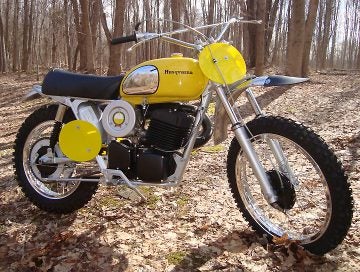
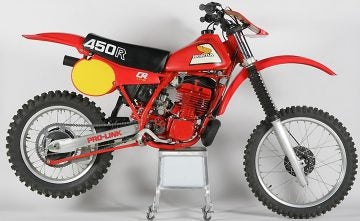
Oh sure, it had a lot of power, but the power delivery was freaky. It would either hit hard, or hesitate, but you were never sure which would happen. Geared for off-road use, low gear would take you out to 45 mph, while fourth gear might squeak up to 80. Topping off its list of bad habits was that it was hard to start when cold, harder to start if you dropped it and when it got hot, and it tended to foul plugs and ping.
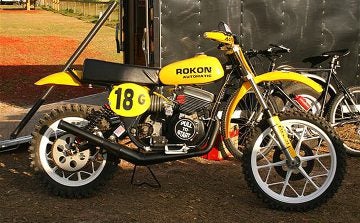
To start the big Sachs engine you had to tug at a rope-starter, which took a strong arm and an even stronger patience level. It came poorly jetted, and when it loaded up you would rip half the calluses off your hand before getting things spinning.
We talked about the belt drive earlier, and the less said about this the better. The thing was fast and had disc brakes to slow it down. Sadly, they worked intermittently, and the master cylinder often boiled over, leaving you with a lever that came back to the grip and a corner that rushed up to meet you. Gearing down was impossible with the torque converter, which meant you free- wheeled into turns and down hills. Spooky.
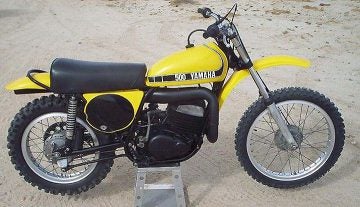
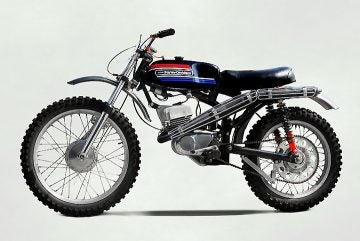
Still, H-D put together a desert racing team that started to dominate the trail bike class, so people went out and bought the Bajas in droves, only to find out they weren’t buying what was being raced.
The race bikes had everything changed! The stock bikes came with rigid footpegs, no horsepower to speak of, a huge overlay sprocket on the rear wheel that constantly came loose, a tank shaped like a mailbox, a saddle that felt like plywood and a strange metal hook strategically placed to rip your crotch off if you crashed. It also had stupid bars, dumb fat grips from a street bike and a suspension that had more side-to-side travel than up-and-down stroke. I called it “a re-hashed Italian street bike with no redeeming traits.” Yes, we promptly lost the H-D ads at the magazine.
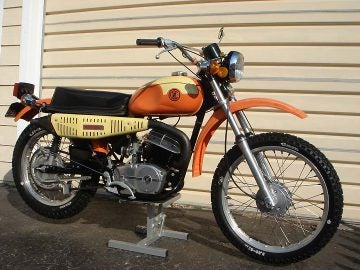
It had rigid footpegs, a huge, bulbous tank, an exhaust that burned the leg, a speedo that didn’t work and various bits and pieces that were attached with pure afterthought technology. The first time I fired up our test bike, the horn fell off on the ground. After I rode the bike 100 yards, the battery fell out and the wiring loom melted. In the next 20 minutes, the plug cap came off, the air filter fell off, the muffler cracked and wedged into the rear wheel, the gas cap leaked, both fuel lines cracked, a tire went flat and the throttle stuck wide open.
The feeble engine was also horribly over-geared, the kickstarter would stick on the frame, fork seals weeped like a garden hose and the motor mounts fell out. This mount signaled the beginning of the end for CZ sales in the United States, and rightfully so.
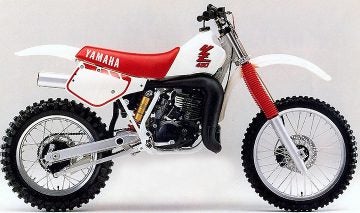
If you jetted it rich enough to keep this dog from seizing, it would blubber, puke, foul plugs and produce no power. If you jetted it to run strong, it would invariably seize. It came with air leaks, a wandering ignition, gimpy motor mounts and the worst case of Yamahop at high speeds since the original DT-1. Yamaha issued a mountain of service bulletins to try to fix the problems. None of them worked.
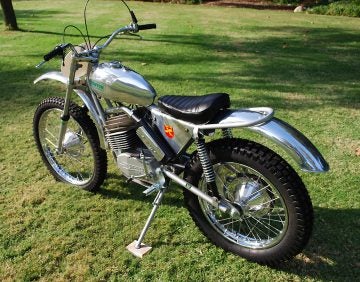
John called it the Penton Trials, but not even Batman could have ridden it in a trials event. There was no power at all, the gearbox was spaced oddly and it wouldn’t turn without plowing the front end. So, in desperation, John renamed it the Mud Lark, a sort of all-purpose play machine. In fact, it was a no-purchase dirt bike, and will go down in history as one of the few bad business decisions ever made by savvy John Penton.
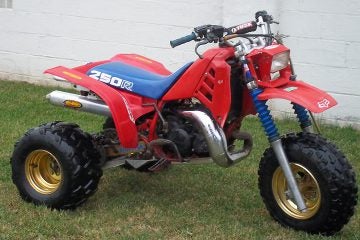
People started doing wonderful things like riding over their own legs and biffing over the bars when the things got into a high- speed wobble-you know, anything over 20 mph. Suspension on these early three-wheelers? Nothing. Zip. Nada. Zero. Just three balloon tires were there to take the impacts.
As the years passed, the ATVs got more and more powerful and they gave them forks and shocks. This let the unstable triangle wallow around, as well as defy the laws of physics when trying to turn. The rest is history. Three-wheelers are no longer being made. However, be warned! They’re still out there, wiggling and lurching around the trails and sandpits of America.
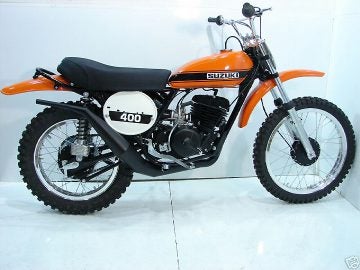
THE 1971 SUZUKI TM-400R CYCLONE! It weighed 242 pounds, dry, and delivered about 40 hp at 6850 rpm. Sometimes it delivered it at 4400 rpm. At other times, it would deliver it just when you least expected it. You see, the Cyclone had a weird ignition that would go from a starting mode to full advance whenever it felt like it. Even a change in temperature would change the power hit.
Picture this: you’re exiting a hard- packed turn in second gear and you roll the throttle on. All of a sudden, the engine lurches into the fat part of the power curve and the rear end leaps out about three feet. The chassis shudders and sends you sailing into the clear blue sky in a nice arc. Moments later, you thump into the ground, painfully, and then a microsecond after that, the Cyclone lands on top of you.
Adding to the bizarre powerband was a set of forks that went rigid on square bumps and rear shocks that faded from anything hotter than headlight glare. Many companies produced endless handling and frame modification kits. None of these things seemed to help much, but the bike cost only $995 brand new and people kept buying them, trying to make them work. They all failed, to one degree or another, to tame the Cyclone.
The legacy of the TM-400 can be summed up in an ad that appeared in a newspaper:
“For sale-1972 Suzuki TM-400. Only ten hours on bike. Possible injury forces sale. $500 or best offer.”
***
SUBJECT: A POEM OF SORTS FROM THE AMAZING DAVE
Now, I got something to lengthen your ever shortening Don’t Ask! column. Rick, keep in mind, I must have spent 5 to 10 minutes ideating, processing and writing this mess so treat it with the respect it deserves! It’s sung to the tune: “(these are a few of) My favorite Things” from the musical “The Sound of Music”.
“Bikes That Need Rings”
A Rokon 340 with a belt drive that slips
an SC500 with a 4 speed that skips
a YZ490 with an engine that pings
these are a few of my bikes that need rings
A CZ250 with a non-sparking stator
a Mini Enduro with a broke carburetor
an XL250 with flimsy valve springs
these are a few of my bikes that need rings
A Cyclone 400 with a weird power band
a Penton Mudlark with a broken kick stand
a kick-starting thumper that tore my hamstrings
these are a few of my bikes that need rings
A Baja 100 with a frame like tin foil
A Bultaco Frontera with a hot, smoking coil
an MX 400 with a monoshock spring
these are a few of my bikes that need rings
A CR450 that shakes like a wet dog
a Can Am Black Widow that handles like a frog
a non-starting TT that’s got me pu-king
these are a few of my bikes that need rings.
Thank you. Thank you very much.
David “TT500” Fruhling
It’s been a while since Dave put together something of this much quality. It is genuinely appreciated.
***
SUBJECT: LOOKING FOR A CZ
Mr. Sieman,
I enjoy your website and am appreciative to you for putting together such useful information. I have a passion for old dirtbikes. My collection seems to continue to grow despite my promise to myself to not buy another item. Presently we own 11 lovely two wheelers.
I have an opportunity to buy a 1969 CZ 250…an enduro not a MX. Just wondering your thoughts about that model. Any insight you can provide is appreciated. Just would love to have a CZ.
Thanks
Fred Thomas
New Jersey
That particular bike shared a lot of parts from the motocrosser. Take way the lights, the pipe and the wide ratio box and you’ve got a motocross bike. The Enduro had less pure horsepower, but had more low-end and midrange torque, so it would last for a good long time.
***
SUBJECT: THOUGHTS FROM WAY BACK THEN
Hi Rick:
You may or may not remember me (if your memory is as bad as mine), but you were a hero and a legend to me. As a high school kid, enthralled by the newly discovered world of motocross and dirt bikes, I remember the day myself and a friend discovered your house in Granada Hills. We could have hung out there 24/7, but you politely shooed us away as the annoyances we probably were.
Fast forward a few years, I got to actually meet you as an adult when we met on the starting line for many a District 37 motocross race. My name, Tom Bice isn’t one for the record books, I never achieved a number one plate, I never went on to become anything in the motorcycle industry, and really all I have at this point in my life are my memories.
While watching a You Tube video ‘In memory of racing friends’ by Steve Bauer, I just couldn’t believe and am saddened so many of our heroes and legends have passed. I found it so hard to believe that the worlds best motocrossers had passed at what I now consider such a young age, and while looking up how many had passed, I ran across your article about the passing of Adolf Weil and the Maico 501, which is what inspired me to send you this note.
I still ride, though not much these days as a result of the economy, still have my bikes sitting in the trailer, and my fondest memories of my 60+ years on this earth are still those of my days as a motocross racer.
Thanks for reading this, may your days be filled with joy.
Tom Bice
Genuine thanks for the kind words. Back in those days, I wrote the magazine for guys just like you, as I think back to then, I relish those thoughts.
***
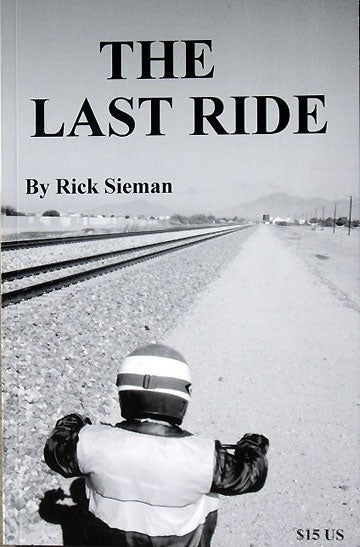 SHAMELESS PLUG
SHAMELESS PLUG
My new book, THE LAST RIDE, is at now out. It’s fiction and starts in 1969, when an 18-year-old kid just out of high school gets a chance to ride his Yamaha 250 DT1 from Pennsylvania to Los Angeles … all off-road. His adventures are truly amazing. The book then jumps 40+ years where the same person, now in his 60s, wants to get that old Yamaha back in his possession and return it home by riding it all off-road across the country again. The book is $15 plus $2.75 for mail anywhere in the US and for more information.
Email: superhunky@gmail.com
Paypal address: superhunky@gmail.com
Websie: www.superhunky@gmail.com
 Your Privacy Choices
Your Privacy Choices